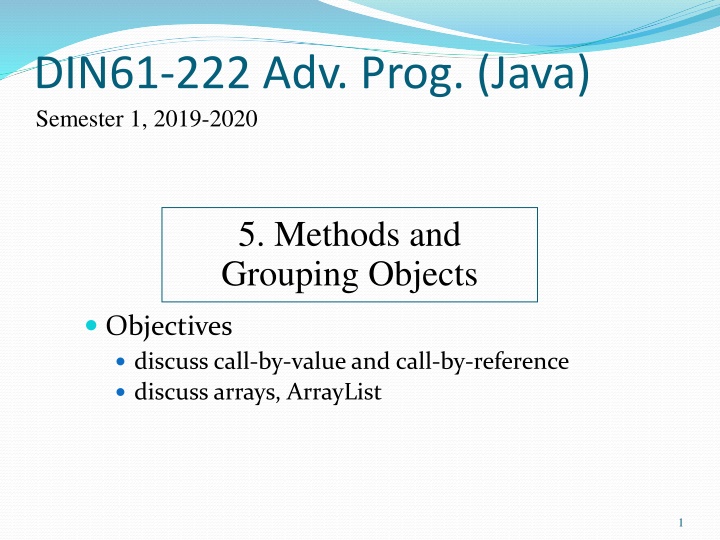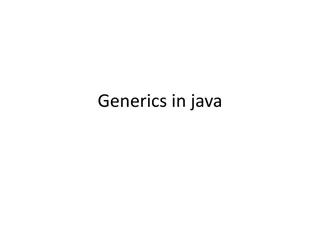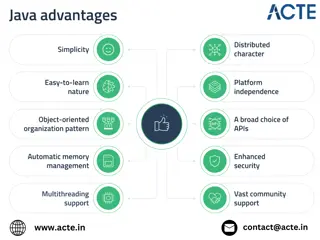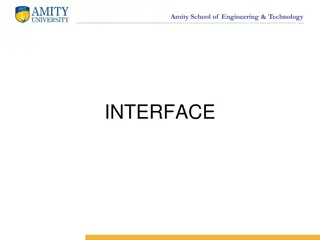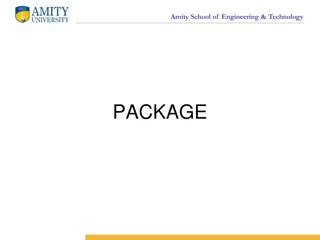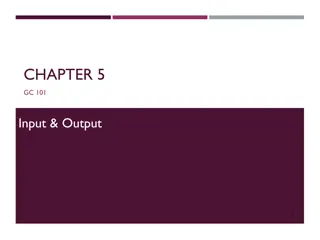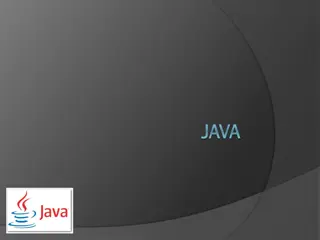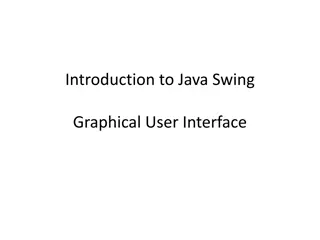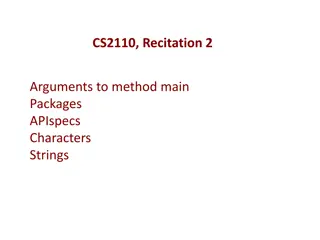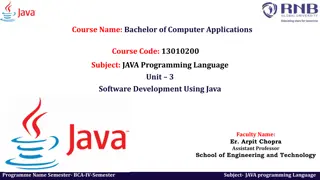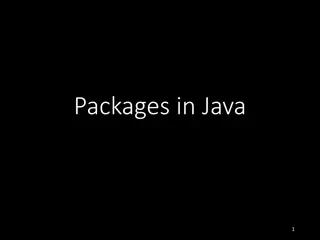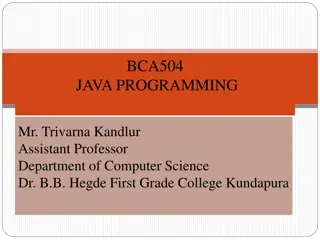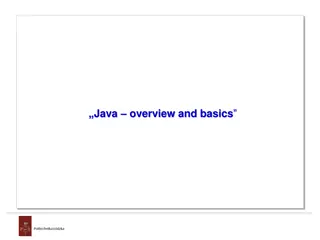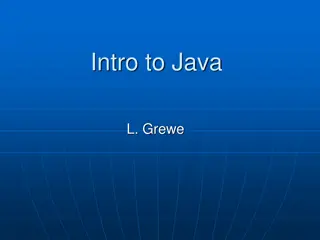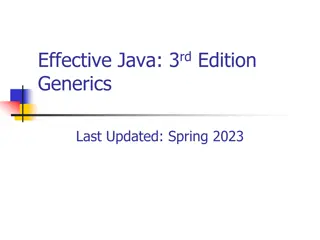DIN61-222 Adv. Prog. (Java)
Explore the concepts of call-by-value and call-by-reference in Java, understanding how parameter passing works through examples. Learn the impact on values and objects in methods, distinguishing between primitive types and object types.
Download Presentation

Please find below an Image/Link to download the presentation.
The content on the website is provided AS IS for your information and personal use only. It may not be sold, licensed, or shared on other websites without obtaining consent from the author.If you encounter any issues during the download, it is possible that the publisher has removed the file from their server.
You are allowed to download the files provided on this website for personal or commercial use, subject to the condition that they are used lawfully. All files are the property of their respective owners.
The content on the website is provided AS IS for your information and personal use only. It may not be sold, licensed, or shared on other websites without obtaining consent from the author.
E N D
Presentation Transcript
DIN61-222 Adv. Prog. (Java) Semester 1, 2019-2020 5. Methods and Grouping Objects Objectives discuss call-by-value and call-by-reference discuss arrays, ArrayList 1
1. Parameter Passing Java use two ways to pass parameters (data) into methods: call-by-value call-by-reference 2
What is Call-by-value? I can use an example in C, which uses call-by-value. void foo() { int x = 2; bar(x); printf("x is %d\n", x); } void bar(int w) { w = 5; } x 2 w "x is 2" is printed 3
To get the new value back to foo(), the w must be returned (copied back): void foo() { int x = 2; x = bar(x); printf("x is %d\n", x); } int bar(int w) { w = 5; x 2 w return w; } "x is 5" is printed 4
What is Call-by-reference? An example for an imaginary language: function foo() { integer x := 2; bar(x); print("x is %d \n", x); } function bar(ref integer w) { w := 5; } x 2 w x is 5 is printed 5
Call-by-reference creates a reference(or pointer) from w in bar() to x in foo() when w changes, x is also changed function foo() { integer x := 2; bar(x); print("x is %d \n", x); } function bar(ref integer w) { w := 5; } x 2 w 6
2. Javas Parameter Passing Variables of primitive types (e.g. int, double, char) are passed call-by-value Object-type variables are passed call-by-reference 7
Java Call-by-Value Example public class SimpleCalls { public static void main(String[] args) { int x = 3; System.out.println("1. x = " + x); squareBad(x); // x = squareGood(x); System.out.println("2. x = " + x); } // end of main() continued 8
static is used so that main() can call these methods without creating an object first; it has nothing to do with parameter passing private static void squareBad(int x) { System.out.println("sqBad 1. x = " + x); x = x*x; System.out.println("sqBad 2. x = " + x); } private static int squareGood(int x) { System.out.println("sqGood 1. x = " + x); x = x*x; System.out.println("sqGood 2. x = " + x); return x; } } // end of SimpleCalls class 9
Execution When calling squareBad() no change to x in main() When calling squareGood() x is changed in main() 10
3. A Counter Class public class Counter { private int val; public Counter(int x) { val = x; } public void incr() { val++; } public int getVal() { return val; } } 11
Making Objects Counter c = new Counter(5); Counter d = new Counter(2); a reference (pointer) c d variable val 5 val 2 Counter object 12
4. Passing an Object to a Method public static void main(String[] args) { Counter c = new Counter(5); foo(c); System.out.println( c.getVal() ); } private static void foo(Counter w) { w.incr(); } What is printed? 6 13
Call-by-Reference Diagram main() foo(Counter w) c reference back to object w val 5 : w.incr(); : : foo(c); sop( c.getVal() ); 14
5. The Meaning of x = y Java has primitive types (e.g. int, char, boolean, etc) and classes (String, Integer, Counter, etc). Assignment for primitive types copies the data value a form of call-by-value Assignment for objects copies the reference a form of call-by-reference 15
5.1. Primitive Type Assignment int c = 5; int d; d = c; // COPY DATA VALUE d c 5 d++; System.out.println( c ); What is printed? 5 16
5.2. Object Assignment Counter c = new Counter(5); Counter d; d = c; // COPY REFERENCE c val 5 d.incr(); System.out.println( c.getVal() ); Counter object What is printed? 6 d 17
6. Arrays Java arrays look like C arrays, but... Arrays are objects, and so are passed to methods using call-by-reference. 18
Createan Array in 2 steps declare a variable create array object with new int c[] = new int[12]; // creates a 12 element int array c[0] = 2; // OK or int c[]; // declares a var; no object yet c[0] = 2; // ERROR! c = new int[12]; // allocates array object c[0] = 2; // OK continued 19
In diagrams int c[]; // declares a variable c c = new int[12]; // create array object ... c 0 1 11 object c[0] = 2; 20
1 3 4 6 n 0 1 2 3 confusing, since no 'new' is required object or: int n[] = {1, 3, 4, 6} // creates a 4 element integer array A common error: int foo[12]; // a syntax error in Java 21
More Ways to Create an Array Instead of: int c[] = new int[12]; // OK Can write: int[] c = new int[12]; // OK ... c 0 1 11 object 22
UseArray.java int n[] = new int[10]; import javax.swing.JOptionPane; or public class UseArray { public static void main(String[] args) { int n[]; // declare var n = new int[10]; // create array object // no values stored in n[], so will contain 0's String output = "Cell Value\n"; for(int i = 0; i < n.length; i++) output += "n[" + i + "] == " + n[i] + "\n"; I've used two lines, just because I can JOptionPane.showMessageDialog( null, output, "Using an Array", JOptionPane.INFORMATION_MESSAGE ); } // end of main() } // end of UseArray class 23
Execution 24
Notes n variable; no object n int n[] n is allocated array objectwith new ... n = new int[10]; n 0 1 9 object n.length lengthalways holds the length of the array object (i.e. 10 in this case) 25
Using an Array Square brackets are used to access an array element: n[i] Array elements are used like ordinary variables on the left of an assignment: n[0] = 3; in an expression: x = n[1] 3; n[i]++; 26
7. Passing Arrays to Methods Arrays are objects they are passed to methods using call-by-reference i.e. changes to an array inside a method affects the original 27
PassArray.java public class PassArray { public static void main(String[] args) { int a[] = { 1, 2, 3, 4, 5 }; System.out.println("Values in the original array:"); for(int i = 0; i < a.length; i++) System.out.print( a[i] + " "); System.out.println(); : 28
modifyArray(a); // pass array call-by-reference System.out.println("Values in the modified array:"); for(int i = 0; i < a.length; i++) System.out.print( a[i] + " "); System.out.println(); System.out.println("Before: a[3] = " + a[3]); modifyElement(a[3]); // pass call-by-value System.out.println("After: a[3] = " + a[3]); } // end of main() continued 29
b is an array var, so passed call-by-reference private static void modifyArray(int b[]) // multiply each element by 2 { for (int j = 0; j < b.length; j++) b[j] *= 2; } no return required private static void modifyElement(int elem) // multiply elem by 2 { elem *= 2; } elem is a primitive type, so passed call-by-value } // end of PassArray class 30
Execution changed unchanged 31
Notes This application uses call-by-reference to change an entire array object, a it changes back in main() It also tries to changes an array element, a[3], by using call-by-value (copying) it does not change back in main() 32
Call-by-Reference Diagram main() modifyArray(int b[]) 1 2 3 4 5 bvariable object reference back to object : a : b[i] *= 2; : modifyArray(a); : 33
Call-by-Value Diagram main() modifyElement(int elem) 2 4 6 8 10 8 elem object : a : elem *= 2; : modifyElement( a[3]); : value is copied over 34
8. Collections of Objects Many applications involve collections of objects: personal organizers library catalogs student-record system The number of stored items varies over time as new items are added and old ones removed. Arrays have a basic problem: their size is fixed e.g. int[] c = new int[10]; what should the size be for a student-record array? 35
Collection Classes Java supports four main kinds of collection classes, which are stored in the java.util package. 36
ArrayList The ArrayListcollection class is a list data structure with no fixed size it grows and shrinks depending on how many objects are stored inside it It's called an "Array" "List" because it is implemented using arrays internally, but that is hidden from us. Think of it as a list. 37
ArrayList Example ArrayList<String> msgs = new ArrayList<String>(); // no fixed size msgs.add( hello ); msgs.add( see you ); String s1 = msgs.get(0); System.out.println( size: + msgs.size()); ArrayList Object 2 msgs 1 0 . . . String objects hello see you 38
remove() Complicates Things msgs.remove(0); System.out.println( msgs.size() ); // 1 String s2 = msgs.get(0); // "see you" ArrayList Object 2 msgs 1 0 . . . String object see you 39
More on ArrayList: Google for "ArrayList API Java 12" 40
10. A Counters Example An ArrayList of Counter objects. ArrayList object 0 1 cnts 2 . . . . Counter objects 41
CountersStore Class public class CountersStore { private ArrayList<Counter> cnts; public CountersStore() { cnts = new ArrayList<Counter>(); } public void add(Counter c) { cnts.add(c); } public Counter get(int idx) { if ((idx < 0) || (idx >= cnts.size()) { System.out.println("Index out of range"); return null; } return cnts.get(idx); } } // end of CountersStore class 42
Using CountersStore public class CountersStoreDemo { public static void main(String[] args) { CountersStore cs = new CountersStore(); Counter c1 = new Counter(5); cs.add(c1); cs.add ( new Counters(7) ); // second object added Counter c = cs.get(1); // get reference to second object c.incr(); // 7 --> 8 System.out.println( c.getVal() ); // prints 8 Counter foo = cs.get(1); // get reference to second object System.out.println( c.getVal() ); // prints 8! } ) 43
The References cs CountersStore object cnts ArrayList object 0 1 2 . . . . c1 5 c Counter objects foo 7 44
11. Generic Classes Collections are known as parameterized or generic classes. The type parameter says what we want in the list: ArrayList<Counter> ArrayList<String> etc. 45
12. Self-study from java9fp Read Chapter 7 (Arrays and ArrayLists) Download, compile, and run some of the examples from this section and from Chapter 7 my code is on the course website in <SITE>/Code/ the java9fp code is on the course website in <SITE>/Other Code/java9fp/java9fp_examples.zip 46
